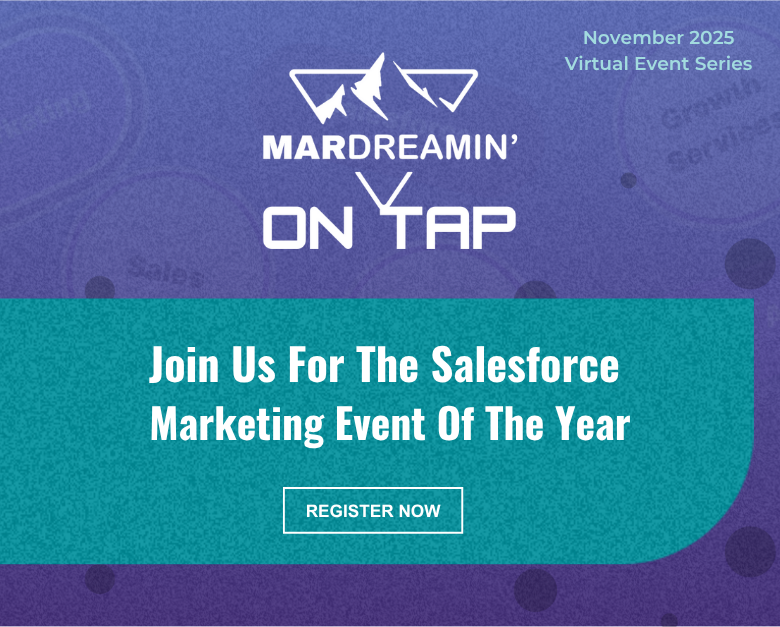Marketing Cloud Growth/Advanced (aka Next Gen Marketing Cloud) is built to leverage the power of Data Cloud, giving marketers key benefits like unified customer profiles, enhanced segmentation, cross-object personalization, and calculated insights. However, these capabilities come with a cost in the form of Data Cloud credit consumption. In this post, we’ll review several tips to help you maximize the benefits of Data Cloud without breaking the bank.
Introduction to Data Cloud Credits
Before we start talking about conserving credits, let’s take a look at what they are and what actions use them.
What Are Data Cloud Credits?
Salesforce defines Data Cloud Credits as “digital currency that you use to pay for Data Cloud services.” These credits are consumption-based, meaning you only pay for what you use. Use a little, pay a little. Use a lot, pay a lot.
Credit use is calculated by multiplying the number of units consumed for each usage type by the corresponding multiplier from the rate card. Usage types include Data Services, Data Storage, Einstein Requests, and Segment Activations. Usage can be monitored in the Digital Wallet included in your Salesforce org.
The key takeaway is that credits are a valuable resource, and every action comes with a related cost. The goal is not to scare marketers or discourage credit usage. It’s to encourage smart, intentional use to ensure that each credit delivers value.
Here are some great resources if you would like to learn more about these topics.
- Get Started with Data Cloud Credit Consumption
- Data Cloud Billable Usage Types
- Get to Know Salesforce Digital Wallet
- Data Cloud Pricing Calculator
- Using Data Cloud Credits in Marketing Cloud Growth Edition: A Guide for Account Engagement Users
Tips for Optimizing Your Data Cloud Credit Usage
Tip #1 – Apply Filters to Data Streams
Identity resolution rules are one of the largest consumers of Data Cloud credits. They use Data Service credits to create the unified individual records required for Marketing Cloud Growth/Advanced. This process is essential and must be activated. But it can be optimized.
Save Credits with Filters
Identity resolution rules link data from multiple data sources into unified individual records. Credit consumption is based on the total number of records that Data Cloud reviews when unifying the records. Credits can be conserved by applying filters to the data streams to limit the number of records being used in the identity resolution process.
Example:
If your lead data stream contains 1M records and your contact data stream includes 500K records, 1.5M records will be used in the creation of the unified individual records. Data filters can be applied to limit the number of records used in the identity resolution process by focusing on only records that should be included in your marketing activities.
Applying Data Filters
Data filters can be applied in two ways:
- When Ingesting: By adding a filter to the data streams
- After Ingestion: By applying a filter to the data lake object (DLO) in the data space (Marketing Cloud uses the default data space)
The filters will impact the system processes like unification, segmentation, and CI, but will not impact the total number in the data stream.
Example:
There are 6,088 total records in the lead data stream (and let’s say that 2,500 are from the USA). If you apply a filter for Country = USA, the total record count in the data stream stays the same (6,088), but only the 2,500 records from the USA will be used in system processes (including identity resolution). This reduces the data being evaluated to only leads in the USA and will reduce credit consumption.
The great thing about filters is that they help save credits across multiple areas. They reduce credit usage in identity resolution and also limit the number of records evaluated in processes like segmentation and calculated insights. This saves you even more.
Tip #2 – Audit Refresh Schedules
Credits are consumed when data is refreshed in Data Cloud. This includes data streams, data graphs, calculated insights, identity resolution rules, and segments.
Data Streams
Data streams based on Salesforce data refresh every 15 minutes by default and upsert with new or changed records. Manual updates can also be triggered if needed. Data ingested from other sources can be scheduled to run hourly or daily, so it’s worth taking a look at their schedules.
If you find the data is being refreshed hourly, consider the frequency that the data is actually updating (in the data source being ingested) and the “freshness” that’s needed in your marketing activities. Hourly refreshes make sense for data that changes frequently and is used in time-sensitive communications. In other cases, daily refreshes might meet your business needs and they would save credits.
Data Graphs
Data graphs are used for personalization and dynamic content, and refresh daily by default. The refresh interval can be updated by navigating to the data graph in Data Cloud and selecting the “Schedule” option from the dropdown (under the ▼icon).
More frequent refresh intervals mean “fresher” data, but will use more credits. I recommend sticking with the daily refresh option and adjusting based on your needs. Remember, manual refreshes can also be triggered if needed.
Identity Resolution
Identity Resolution rules run daily and the schedule can’t be changed. The rules will run once every 24 hours and the time of day might vary based on your org and the amount of data being processed. Manual refreshes can be triggered by navigating to the rule and clicking the “Run Ruleset” button.
The only real optimization for identity resolution is limiting the number of records processed (by applying filters) as discussed in the first tip.
Segments
Segment refresh schedules are the primary way that marketing teams can reduce Data Cloud credit consumption. When creating a segment, the Standard Publish option offers the following refresh schedules:
- Don’t refresh
- 12 hours
- 24 hours
I recommend choosing “Don’t refresh” unless there’s a defined need to refresh more frequently. This ensures segments aren’t needlessly refreshing—and burning credits unnecessarily.
Make sure your segments are still up to date before sending emails by selecting the “Immediately before running this flow” refresh option in your segment-triggered flow. This guarantees your email targets the most current segment population, without incurring extra credit usage from scheduled refreshes.
Tip #3 – Be Selective
Data storage is another factor to consider when evaluating credit consumption. When ingesting data into Data Cloud, start with a minimalist mindset. Ask yourself the following questions when deciding which fields to include:
- Is this field needed for identity resolution?
- Is this field needed to support marketing efforts (ex. dynamic content, personalization, segmentation)?
- Is this field used in calculated insights?
If the answer to these questions is “no,” hold off on ingesting the field to reduce unnecessary data storage. If a new use case arises later, the field can always be added to the data stream.
How to add a field to an existing data stream
- Confirm the Data Cloud Salesforce Connector has read access to the field.
- Permission Sets > Data Cloud Salesforce Connector > Object Settings
- Navigate to the object that contains the field and verify the “Read Access” box is checked
- Permission Sets > Data Cloud Salesforce Connector > Object Settings
- In Data Cloud, select the Data Streams tab and the data stream related to the object where the field is located.
- Click the “Add Source Fields” button from the selected data stream.
- Select the field (or fields) from the table and save.
- Click the “Review” button in the Data Mapping section and map the fields from the data lake object to the data model object (you might need to create new custom fields).
Make the Most of Your Credits
Data Cloud credits are a valuable resource and should be managed accordingly. With a little bit of planning and some regular audits, you can make the most of your credits and take full advantage of the AI, calculated insights, personalization, and segmentation capabilities of Marketing Cloud Growth/Advanced.
If you have questions about Data Cloud or Marketing Cloud Growth/Advanced reach out to the Sercante team or leave us a comment.









